75th Annual Meeting
Since 1948, the Vermiculite Association (TVA) has promoted vermiculite’s diverse uses and facilitated the exchange of technical knowledge and best practices in the industry.
Our annual meeting provides a platform for industry experts and stakeholders worldwide to discuss significant topics that shape the future of our industry.
We will celebrate our 75th anniversary meeting this year, making it an event you’ll want to attend.
The celebratory 2024 Annual Meeting will be held in San Diego, California, from April 23 to 25. This year’s meeting promises to be an unforgettable experience, with exciting activities and opportunities to learn and network with like-minded individuals worldwide.
Mark your calendar and stay tuned for more information about this upcoming event. Take advantage of the opportunity to celebrate our 75th anniversary meeting with us!

Hear from industry speakers and participate in group discussions on topics including:
• Navigating the AI Landscape
Dr. Henrik Christensen, Qualcomm Chancellor’s Chair of Robot Systems, UC San Diego and Director, Institute for Contextual Robotics
• The Carbon Footprint of Vermiculite
Chuck Vogelsang, Technical and Operations Consultant
• Process Monitoring & Data Presentation
Chuck Vogelsang, Technical and Operations Consultant
• Mining Panel
• Exfoliator Panel
Book Your Hotel Room Today
La Valencia Hotel
1132 Prospect St
La Jolla, CA 92037 (855) 476- 6870
TVA has negotiated discounted room rates for the annual meeting. Make your reservations online or call 1-800-451-0772 and ask for The Vermiculite Association room block. The reservation deadline is Thursday, March 28, 2024.

Share Your Memories With TVA!
Participate in TVA’s 75th Annual Meeting Digital Time Capsule
This year, TVA is celebrating its 75th Annual Meeting in San Diego, California, from April 23 – 25, 2024. As part of the celebration, we are collecting photos, testimonials, anecdotes, and memories from our members to celebrate this Annual Meeting milestone.
How Can You Participate?
Click here to schedule a 10-minute Zoom call with TVA’s Communications Associate, Matthew Zemba. During the interview, we’ll ask questions related to your TVA experience, such as:
• What is a fond memory you have of TVA?
All rooms in our block are available on a first-come, first-serve basis. The negotiated room rate is only available until our block is full or the deadline date is reached.
Room Rate: $389.00 (plus taxes and fees for single and double occupancy and $30.00 resort fee* per night)
*The daily resort fee includes morning jogging cart, highspeed Wi-Fi, two in-room water bottles, 24-hour fitness center & business center access, in-room coffee & tea, one-hour complimentary bike rental, golf cart transportation (one-mile radius), cookies with the concierge, seasonal guest activities and entertainment, PressReader digital newspaper & magazine access, and 10% off La Valencia merchandise.
Click
Group Code: 2404THEVER
• What do you enjoy most about your membership?
• What are you most looking forward to with TVA and its work?
• Why is TVA important?
Send us your photos and videos via email to: commassoc@vermiculite.org or mail to: 2207 Forest Hills Drive, Harrisburg, PA 17112.
The deadline for content is March 15, 2023.
If you have any questions or you are unable to connect via Zoom, please email Matthew Zemba at commassoc@vermiculite.org
Message From the President
by Jeffrey Sheehy, Sr.This year, TVA marks our 75th Annual Meeting! To celebrate, we want to be intentional about preserving the historical knowledge of the Vermiculite Association. We will reminisce, as well as document the importance of TVA today, so that in future years, we can look back on this important milestone. Please participate by sharing your historical and present photos and anecdotes for our digital time capsule that we are making for the 75th Anniversary Meeting. Contact TVA’s Communications Associate, Matthew Zemba, at commassoc@vermiculite.org to join in.
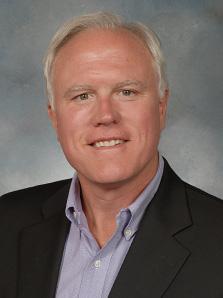
As we embark on another year of advancing the interests of our industry, let’s take a moment to reflect on the importance of the foundation upon which we build our understanding of the industry landscape. It provides context for the challenges we face today and the opportunities that lie ahead. I’m also encouraged when I think about how we have worked together and continue to join forces for the betterment of us all.
I believe our association’s discussion of the reporting and recordkeeping requirements for asbestos under the Toxic Substances Control Act (TSCA) is an excellent example of the value of our collective. Our meetings have allowed us to ask questions and share insights on the topic. (You can find more information in the article on page 4.) And we will continue to monitor it. Another meeting is scheduled for March 11.
Finally, I hope I will see you at our meeting in San Diego in April! Please reach out to others who would benefit by attending. It will be a time of honoring our past, celebrating our association, and leveraging our collective wisdom as we look toward the future.
Thank you for your dedication and support.
In future issues of TVA's Lightweight News newsletter, we want to highlight our amazing members. Spotlight your company and share your experience in the industry!
Do you want to be featured? Simply click the button below and fill out our interview survey. You can also include a headshot and/or your company logo, please email Communications Associate Matthew Zemba at commassoc@vermiculite.org.
Click Here to complete our interview survey.
Spotlight
Q:
a laboratory technician at the age of 16 at a local brickworks that produced building bricks, Fireclay bricks and High-Temperature Bauxite bricks for steel ladle linings. A move of employer some 10 years later (1974) took me to what is now Dupré Minerals Ltd (previously Hoben Davis Ltd) as Assistant General Manager. It was here that I became fascinated with the production of vermiculite through two antiquated "Mantoc" furnaces, so to date, I have been involved with vermiculite for some 50 years!
Q: Tell us about your company and what you do in your current position.
A: I retired from Dupré in 2018; however, itchy feet and a realization that my life's work was my biggest interest, I decided to start my own consultancy business without great expectations, it has to be said. Within weeks I was called upon to advise a miner in China, a country that I know well. Then along came COVID, just three months after my return from Wuhan, of all places! Since then, the demand for my services has been a constant in my life.
Q: What is the biggest industry-related change or challenge you've seen over the years, and what have you done to overcome it?
A: The biggest change, I can say, has been the demand by end users for tighter and tighter quality demands, which goes all the way down the line back to miners. The biggest challenge we face today is cost increase and competition from other products. While supply from miners has always been a thorny

Q: How long have you been a member of TVA, and why did you join?
A: My membership with TVA goes way, way back, maybe over 40 years. I served as a Director of TVA and often attended annual meetings. I joined TVA as vermiculite became my focus at Dupré, and my vision was to become totally immersed in vermiculite and its applications. Joining TVA allowed me to network with like-minded people.
Q: What do you enjoy most about your membership with TVA?
A: The newsletter and Mike Darling’s contribution is always a good read. The annual meetings are a highlight and are very informative.
Q: Tell us a fun fact about yourself.
A: Well, it’s not so much fun for the family, but my son Robert and I (who is now General Manager at Dupré Minerals Ltd) are not
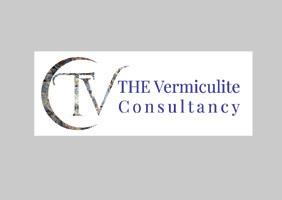
Important Update on EPA Regulation
As many of you are aware, the EPA finalized reporting and recordkeeping requirements for asbestos under the Toxic Substances Control Act (TSCA) last year. The reporting period begins February 24 and runs through May 24. Because the opening of the reporting period is coming soon, the TVA Board thought it would be beneficial to send this guidance document to all members. Many members have been monitoring this, along with TVA, and each company will need to determine which form they feel they should use to be compliant. Once the reporting period begins, TVA will keep an eye on any changes, potential changes or additional information as it becomes available.
After the reporting period is active, TVA will hold a Zoom meeting for members to discuss this further. The Zoom meeting is tentatively scheduled for Monday, March 11, 2024 at 11:00 a.m. Eastern. You fill find the Zoom access details below.
TVA Board of Directors
President
Jeffrey Sheehy, Sr.
Whittemore Co. Inc.
Lawrence, Ma. 978-681-8833
jsheehy@whittemoreco.com
Term expires 2024
Vice President
Matt Goecker
Specialty Vermiculite
Bala Cynwyd, Pa. 775-287-9796
mgoecker@dicalite.com
Term expires 2024
Treasurer
Dan Metz
Virginia Vermiculite
Louisa, Va.
540-967-2266
dan@virginiavermiculite.com
Term expires 2024
Meeting ID: 870 9379 7180
Passcode: 815722
One tap mobile:
+16469313860,,87093797180#,,,,*815722#
Dial by your location:
+1 646 931 3860 US
Find your local number
Immediate Past President
Tim DeJarnette
The Strong Company Pine Bluff, Ark. 870-535-7617
timdejarnette@strongseal.com
Term expires 2024
Director
Jim Juron
Traxys North America
New York, N.Y.
201-302-0888
jim.juron@traxys.com
Term expires 2023
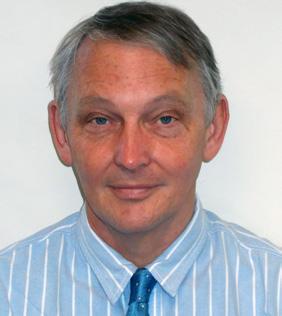
Trade Show News
From the Desk of Your Technical Consultant
The Latest News, Observations and Insights Into the World of Vermiculite
by Mike Darling
Intermat Paris, France April, 24 to 27, 2024. The essential gathering for construction professionals.
Location: Paris-Nord Villepinte. Intermat offers you a chance to meet and build close ties with manufacturers and suppliers, chat with industry experts, and discover the latest trends and technological innovations in construction.
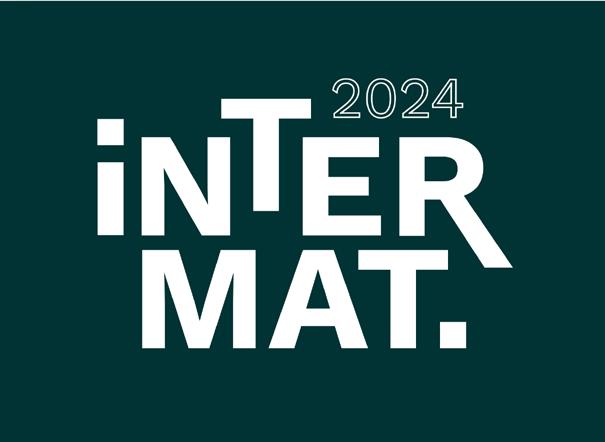

From the Desk of Your Technical Consultant
Geological and Mining News
The Bitterroot National Forest and Carbonatite Hosted Mineral Deposits
The Bitterroot National Forest comprises a 1.6 million acre forest in southwest Montana and Idaho in the United States. Within the National Forestadministered land, there were a significant number of now-defunct—mainly non-metallic—mineral mining operations. In fact, approximately 147 individual mine sites lie within the borders of the forest. Several of these produced vermiculite from time to time over the years, and these include
• Sansbury Vermiculite Mine close to Willow Mountain. The Stansbury Mining Company most recently operated this mine in the 1990s. It lies to the north of St. Clair Creek.
• Skalkaho Vermiculite Deposit near Burnt Fork Lake.
• St. Clair Vermiculite deposit east of Hamilton and at the head of Gird Creek.
• The Sheep Creek Columbite deposit is also cited as containing vermiculite, although no commercial exploitation of the vermiculite is known.
HERE is the full open file report.
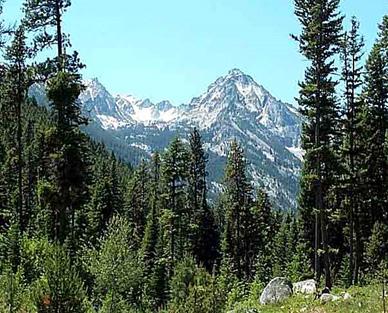
Historian-Author Tells History of Vermiculite Mining in South Carolina, USA
Here is a news item relayed by John North, of the Asheville Daily Planet, October 15, 2023.
Per keynote speaker
Drew Hines, “According to Geraldine Eppley and Candace Rathbone’s excellent and detailed study of the Tigerville community, called ‘Tigerville: A Journey Through Time,’ a bed of vermiculite was discovered close by in 1938.” Continuing, Hines stated, “Vermiculite was an important ingredient for certain insulations. We most probably know it best as the chief mineral found in most potting soils.

“It was determined that this depository of vermiculite was surpassed only by one in Montana, and it was, therefore, deemed worthy of being commercially mined. In fact, two corporations, the Bee Tree and the Universal Zonolite Insulation Companies, would build commercial operations closed to the Tiger River to take advantage of the estimated 250,000 tons of vermiculite that would be available for the taking.
“The mine was 30 to 50 feet deep and employed 10 miners who would descend into the mine shaft to harvest the vermiculite. The soil then went through an intricate refining process that included heating it to over 2,000 degrees that would expand it. Then, it was bagged and sold commercially. This processing operation was located in (nearby) Travelers Rest.
“This marble slab is all that remains of the mine. But it and the marker we dedicate today will remind us of this important commercial enterprise that once flourished here in the hills of northern Greenville County.”
Read the full story HERE
From the Desk of Your Technical Consultant
Sheep Creek Rare Earth Element (REE) Deposit’s Rare Earth Samples Exceed the Highest Grades in the United States
The Sheep Creek project area is in Ravalli County, Montana is an hour from Darby and at the head of the West Fork Bitterroot River.
US Critical Materials Corp. announced Tuesday, February 21, 2023 that rare earth samples from 125 feet underground at its flagship Sheep Creek property in Southwest Montana report grades that exceed any other domestic rare earth resource. US Critical Materials said the claims at Sheep Creek contain 12 of the most essential critical minerals needed for electrification and to establish a domestic supply chain, as North America’s reliance on China for rare earths has become increasingly untenable.
Critical Materials president Jim Hedrick—a former rare earth commodity specialist for the USGS—said the combination of high-grade rare earths, low thorium, and carbonatites 125 feet below the surface is a geological phenomenon that “does not exist in other reported US deposits.”
Hedrick said the pre-resource-stage deposit is valued at a “conservative” $43 billion.
Editor’s Note: No mention of any vermiculite occurrence within this specific ore body is made.
However, The Missoula Current News (a daily news feed in Missoula, Montana, USA) runs a slightly different story about this Rare Earth Element prospect, and highlighting the potential dangers of the potentially asbestiform minerals present in this complex ore body. It also draws the reader to consider the parallels to the long-closed vermiculite mine at Libby, Montana.
The proposed Sheep Creek Rare Earth mine at the head of the West Fork Bitterroot River presents many environmental and economic problems. One in particular deserves early attention. The mineral actinolite is reported to occur in significant quantity at the Sheep Creek REE deposit. Actinolite is a mineral that can have several forms, including asbestiform. In that form, it is “amphibole asbestos” and is closely related to tremolite asbestos that has caused the death of hundreds of people in Libby, MT. Amphibole asbestos is more toxic than other forms of asbestos.
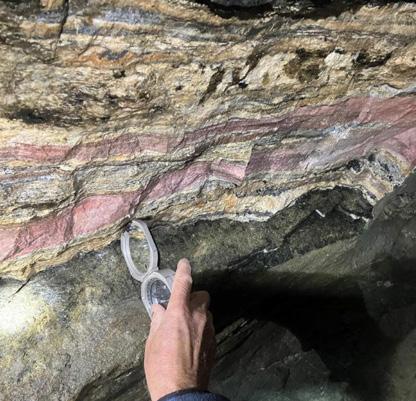
From the Desk of Your Technical Consultant
Peeps Into the Past: Vermiculite in Kenya

Bulletin of the Imperial Institute, Volume 46, Part 2. 1948.
Author: Dr. E.R Varley of the Minerals Resource Department of the Imperial Institute.
The British Geological Survey (BGS) has recently digitized and uploaded many interesting historical documents from its archives.
This particular one of potential interest to us is in relation to the potential for vermiculite in Kenya in the early post-war years. Pages 235 to 239 of this bulletin (as originally produced by the British Imperial Institute in London back in 1948), describe vermiculite deposits in Kenya. This same exact text was later used verbatim in the Colonial Geological Surveys Mineral Resource Division Handbook on Vermiculite, as published by Her Majesty’s Stationary Office (HMSO) in 1952, and priced at 7 shillings and six pence!
The modern flag of the Republic of Kenya is reproduced below.

Vermiculite from Kopaonik (Yugoslavia). Characterization and Processing.
Authors: R. Tomanec, S. Popov, D. Vučinič, & P. Lazič, all of the Faculty of Mining and Geology, Belgrade (capital of Serbia).
Published in: Physicochem. Probl. Miner. Process. (31) 1997.
Abstract: In the last few years, many non-metallic minerals, including vermiculite, have been subject to geologic and mineral processing investigations in Yugoslavia. In this study, the identification of vermiculite from the Kusici–Kopaonik deposit (Yugoslavia) was carried out using microscopy, DTA, TGA, X-ray and IR spectroscopy methods.
In addition, a small amount of chlorite was identified in the examined sample by X-ray method. Expanding properties of different size fractions of vermiculite were performed, followed by the use of a stereomicroscope and by measurement of the volumetric mass before and after the expansion. The maximum expansion was accomplished at 910 - 920 °C. The IR spectra showed that heating of vermiculite at this temperature (about 900 °C) for only 7 minutes resulted in a notable reduction of absorption band characteristics for water, indicating the important water loss from the mineral.
See more information HERE
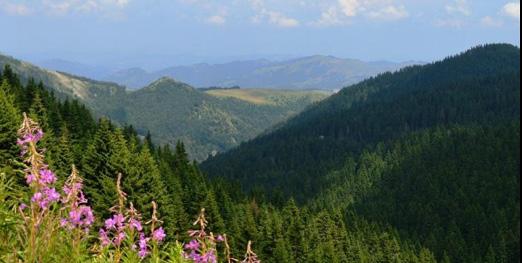
Image above: Kopaonik National Park
Editor’s Note: Kopaonik is a mountain range located in Serbia and Kosovo (formerly Yugoslavia). The highest point is Pančić’s Peak at 2,017 meters. The central part of the Kopaonik plateau was declared a National Park in 1981, which today covers an area of 121km2
From the Desk of Your Technical Consultant
Novel Vermiculite Uses
How Do Lith-Ex Fire Extinguishers Work?
More news about vermiculite dispersions being used to fight Lithium-ion battery fires
Firechief Lith-Ex Fire Extinguishers contain Aqueous Vermiculite Dispersion (AVD), a revolutionary fire extinguishing agent designed to put out Lithium-ion battery fires fast.
The water content of the extinguisher cools the fire source, while the vermiculite platelets encapsulate the fuel source, creating a thermal barrier to prevent the propagation of the fire. The vermiculite film is not electrically conductive, so AVD is nearly twice as effective as water on Class A fires and is environmentally friendly.
Lithium-ion batteries present a more frequent fire hazard each day as the number of consumer and industrial goods powered by them increases. Firechief Lith-Ex Fire Extinguishers are suited to confined spaces where fires need to be suppressed in their infancy before developing into fully established fires. They can also be used to protect against fires where batteries are under charge and where batteries are stored, for example, goods distribution, battery collection bins, battery recycling locations, public services, and battery charging stations.
To find out more about AVD and how Lithium-ion extinguishers work, please see HERE
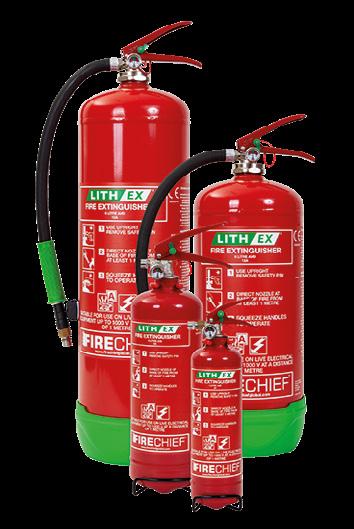
Catching up with the Bicycle Association on its Plans for a UK-Wide Battery Collection and Recycling Service
By Daniel Blackham,November 28, 2023
In March, the Bicycle Association (BA) unveiled plans to launch a UK-wide battery collection and recycling service. Daniel Blackham spoke to Stephen Holt to see how the scheme is progressing.
The BA is currently undergoing a trial of the collection program in the North West at the moment where ERP (European Recycling Platform UK) is visiting 45 retailers.
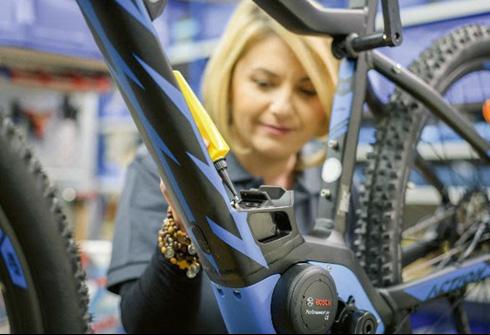
As part of this, the retailer receives a UN-rated fireproof drum to store the batteries. The drum contains vermiculite, which means it won’t go up in flames – that’s provided to them free of charge. ERP also provides some best-practice storage and handling tips.
When ERPs visit those retailers, they also collect any batteries the retailer needs to be removed, as well as helping to inform the BA’s planned national launch next year.
From the Desk of Your Technical Consultant
“HotHands” Hand Warmers
Lining the shelves of Walmart is a highly-rated gadget retailing at just $3 and designed to keep you warm for up to 18 hours.
This story is brought to you by Erica Scalise of the US Sun newspaper and was published online on November 29, 2023.
This popular retail store is selling a top-rated product to help you stay warm on the cheap this winter. HotHands contain a mixture of natural ingredients that react together to produce heat when exposed to air. This happens through an extremely fast oxidation process. The odorless warmers are made of natural ingredients and are TSA-approved and safe for air travel. With no battery attachments, HotHands are smooth and portable and weigh about a third of a pound each. Each packet contains a mixture of iron powder, water, salt, activated charcoal and vermiculite to ensure prolonged and continuous heat output.
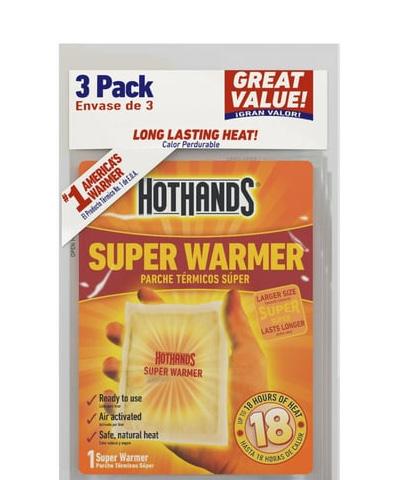
Vermiculite Based High Temperature and Abrasion-Resistant Coatings for Use on Permanent Molds for Gravity Die Casting of Aluminium Alloys
The A. Cesana Company of Italy, established in 1879 by Alfonso Cesana, is a leading manufacturer of metallurgical treatments for non-ferrous metals, castings release agents, and coatings used for low-pressure and gravity die casting. It also produces many chemical products used in the foundry trade.
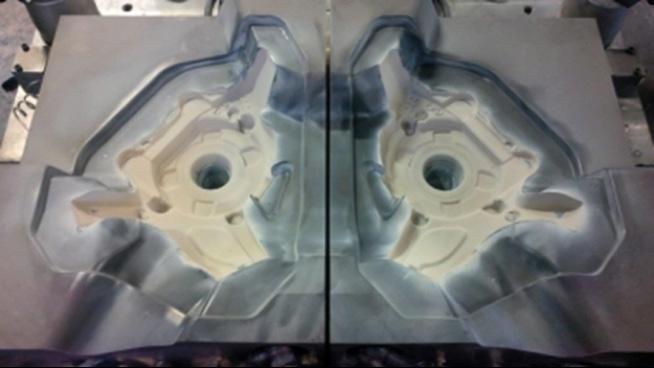
The Cesana product VERFLEX 14/1 is a vermiculite-based coating suitable for any use and particularly resistant to abrasion and high temperatures on permanent molds of aluminum alloys gravity die casting. It is recommended for the production of castings with perfect surface finish. The product has a long duration and is widely used when a large series of castings are produced. It helps directional solidification and slows down the cooling behavior of the alloy.
Read more HERE
From the Desk of Your Technical Consultant
Exploring Sustainable Alternatives to Vermiculite in Gardening
Here is an “interesting” view about the sustainability and environmental impact of using vermiculite in horticulture and a discussion of a potential alternative from Hardy’s Cottage Garden Plants in Whitchurch, Hampshire, in the United Kingdom.
Vermiculite is widely used by professional and recreational gardeners. Our concerns over vermiculite’s lack of sustainability and environmental and health impacts have led us to reconsider our use and look for other products that can do the same job.
How is vermiculite made?
Vermiculite is a “hydrated magnesium aluminum silicate mineral which resembles mica in appearance.” (The Vermiculite Association). Found in rocks, it is mined using open-cast methods. Following extraction and sorting, vermiculite is exfoliated. This involves heating the vermiculite flakes to temperatures of 1000 degrees plus. Extraction and sorting may happen in a different place to the exfoliation processes.
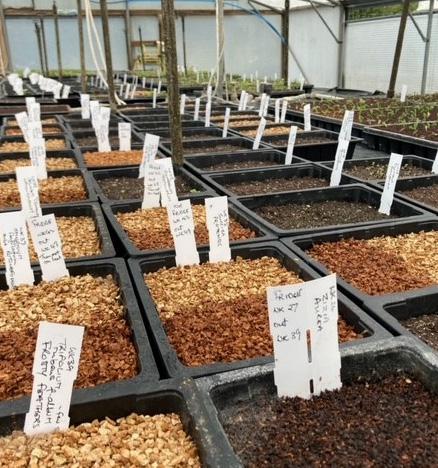
So what’s the problem?
As vermiculite comes from rocks, it is a finite resource. It’s not sustainable. The mining and extraction of vermiculite affect the local ecology. While manufacturers take care to minimize the impact of open-cast mining on air and water quality, the act of removing vegetation, soil and rock severely degrades the landscape. Although manufacturers take steps to restore the landscape once the mining has stopped. It can take many years for the landscape to return to a pre-mined state. In some cases, the ecology never recovers. The mining, extraction, processing and transportation of vermiculite requires significant amounts of energy. All of which contribute to carbon emissions. For those involved in the mining and processing of vermiculite, exposure to quartz during the process can result in silicosis of the lungs.
What’s the alternative?
Hardy’s has been trialing the use of ground cork as an alternative to vermiculite. Cork trees will regrow once stripped, meaning it’s a sustainable product. It takes less energy to manufacture, process, and transport cork from the manufacturers, mainly from Portugal to the United Kingdom. Carbon emissions associated with this product are lower. But those working in the cork industry still need to protect themselves against inhaling cork dust, which has been linked to respiratory illnesses. Initial results suggest that sprinkling a layer of cork over our seeds and cuttings is as effective as vermiculite in preventing mold and retaining surface moisture. Hardy’s is also trialing using a larger grade cork in our propagation house.
Technical Papers
a listing of literature about the use of vermiculite by
Mike DarlingMicrobial resistance stability of rice straw biochar with vermiculite modification: A novel insight into persistent free radicals and pore structure
Authors: Yuxue Liu, Rui Wang, Lili He, Cunjun Li, Yuying Wang, Haohao Lu, & Shengmao Yang.
Published in: Journal of Environmental Chemical Engineering. Volume 11, Issue 5, October 2023.
Abstract: Biochar is considered a promising material for carbon sequestration owing to its high stability. However, the effects of biochar properties, especially pore structure and persistent free radical (PFR) content, on its microbial resistance stability (MRS) remain unclear. Incubation experiments were conducted to investigate the anaerobic and aerobic MRS of rice straw biochar produced at 300–700 °C, with and without vermiculite modification, and to evaluate the relationship between key biochar properties and MRS.
The results showed that PFR signal intensity in biochar was much higher under anaerobic conditions than under aerobic conditions, increasing with production temperatures of 300–600 °C but sharply decreasing at 700 °C. Anaerobic MRS of biochar produced at 700 °C was lower than that of biochar produced at 300–600 °C, as indicated by higher CH4 emission. Redundancy analysis revealed a negative correlation between PFR concentration and cumulative CH4 emission with a correlation coefficient of –0.467 and a positive correlation between cumulative CH4 emission and pore volume and specific surface area with correlation coefficients of 0.405 and 0.281, respectively.
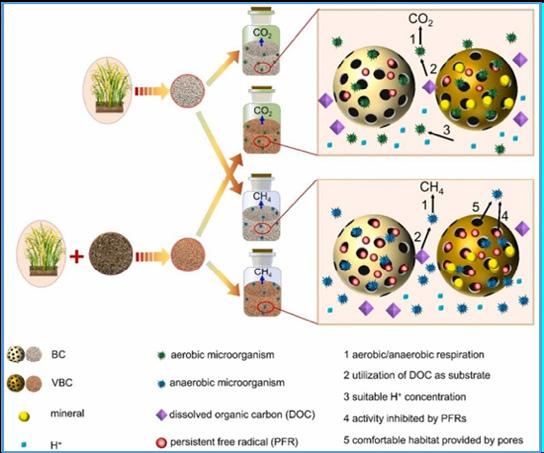
Biochar dissolved organic carbon content, and pH were the two most important factors affecting aerobic MRS as reflected by their high correlation coefficients (0.933 and –0.848) with cumulative CO2 emission. Vermiculite modification enhanced MRS and accordingly lowered the global warming potential of biochar produced at low temperatures (300–500 °C) by 4.59–20.2% and 15.3–42.9 % under anaerobic and aerobic conditions, respectively. However, it had a contrasting effect on biochar produced at 700 °C. Biochar would be more effective at mitigating global warming in paddy fields than in dry lands.
Study of Enrichment of Vermiculite Ores of the Tebinbulak Deposit of the Republic of Uzbekistan
Authors: Avaz Aripov, Fozil Akhtamov, Quvonchbek Bektamishov, Aslonbek Ikromov, & Farxod Erkinov.
Published in: Chemistry in Building Materials. Volume 2, Issue 1, No. 2. Published online February 6, 2023.
Abstract: The mineralogical and technological properties of vermiculite raw materials are analyzed in the article, and the main properties of natural vermiculite are studied. As a result of the tests, a technological scheme for dry beneficiation of vermiculite ores was developed. The output of vermiculite concentrate by fractions is 10.57%, its amount in enrichment is 85%, and the separation of vermiculite in enrichment is 95.95%.
Technical Papers
a listing of literature about the use of vermiculite by
Mike DarlingEnhancing Thermal Behaviour of Concrete Pavement by Incorporating Vermiculite
Authors: Akash Kumar, Prakash Somani, Amit Sain, Arun Gaur
Published in: Materials Today. Available online August 3, 2023.
Abstract: In the current state, the use of the vehicle has rapidly increased all over the world. It happens due to the increase in population as well as vehicle users. So, it becomes necessary to provide a durable and efficient transportation system.
Nowadays concrete pavements are extensively used as compared to the bituminous pavement in road construction. Concrete pavement is more durable due to its better strength and sturdiness; however, concrete pavement is affected because of temperature stresses which cause the formation of cracks inside the pavement. Cracks in the pavement develop as a result of the combined effects of thermal stress and wheel load.
The study’s findings demonstrate the effectiveness of extended vermiculite (EV) in reducing temperature stresses in concrete pavement. Expanded vermiculite has very low thermal conductivity. To check the behavior of expanded vermiculite, thermal stresses and compressive strength tests have to be performed on the M30 grade of concrete with a percentage variation of expanded vermiculite 10%, 20%, and 30% as in partial substitution with fine aggregate by volume. Alccofine is an additive material that enhances strength. Alccofine is added 10% by the weight of cement. An outdoor heat simulation test was performed to determine thermal stresses in concrete. Results proposed a decrement in temperature stresses in the concrete pavement as the proportion of expanded vermiculite increased
Carbon Nanosheets Prepared With a Vermiculite Template for High-Performance Lithium-Ion Batteries via SpaceConfined Carbonization Strategy
Authors: Hui Guo, Zhenshuai Wang, Baolin Xing, Huihui Zeng, Ruiqin Gao, Guangxu Huang, Jianbo Jia, Yijun Cao, & Chuanxiang Zhang.
Published in: Journal of Alloys and Compounds. Volume 933, February 5, 2023.
Abstract: Carbon nanosheets (CNSs) having both graphite microcrystalline layers and amorphous carbon structures are prepared by a space-confined carbonization strategy using glucose, sucrose and starch as carbon sources, which are inserted into the confined space of vermiculite templates by liquid-phase impregnation intercalation.
The microstructures of CNSs are strongly dependent on the molecular weight of carbon precursors. In the Starch-CNSs synthesized from starch with larger molecular weight, single nanosheets contain more ordered graphite microcrystalline layers and fewer microporous defects as well as richer oxygen-containing functional groups, and the disordered stacking of single nanosheets form more mesoporous structures. The specific surface area and nanosheet thickness of StarchCNSs is 400 m2·g−1 and 3.934 nm. Starch-CNSs as anode for lithium-ion batteries exhibit excellent lithium storage properties, combining initial Coulombic efficiency (56 %), high specific capacity (637mAh/g at 0.05 A/g), excellent rate performance (253 mAh/g at 2 A/g) and cycling stability (262 mAh/g at 2 A/g after 500 cycles).
These results show the CNSs derived from larger molecular weights outperform those from lower counterparts, providing strong evidence and reference for selecting suitable molecular weight carbon precursors to prepare highperformance CNSs anode for lithium-ion batteries.
Technical Papers
a listing of literature about the use of vermiculite by
Mike DarlingVermiculite-Derived Cationic Molecular-Intercalated Fluorescent MgAl-LDHs for Assembling Ultrathin Solid-State Light-Emitting Films
Authors: Houmei You, Jinpeng Hou, Yiwen Shen, Xiangkun Zhang, Jiaxue Cai, Yaya Zhang, Yongjun Feng, Weiliang Tian, & Kewei Zhang.
Published in: Chemical Engineering Journal, Volume 470, August 15, 2023.
Abstract: Solid-state light-emitting devices are of special interest in optoelectronic applications owing to inherent advantages in terms of low cost, high efficiency and desirable durability. However, the accumulation of solid fluorescent chromophores causes serious energy transfer, resulting in fluorescence quenching. Herein, exfoliated vermiculite (VMT) was structurally disassembled into Mg-O octahedral and Si-O tetrahedral layers to produce hydrotalcite (LDHs) and SiO2, respectively, realizing efficient utilization of each component and VMT surface.
The fluorescent intercalated LDHs were intercalated with organic fluorescent dyes, including rhodamine 6G (R6G), pyronine G (PG) and sodium fluorescein (Fl-Na), to prepare high-performance fluorescent LDHs, which was further assembled with VMT nanosheets to form ultrathin solid-state light-emitting films. Based on the electrostatic self-assembly strategy, the localization of chromophores and light-emitting intensity of solid films can be precisely controlled by adjusting ordered multilayers. In fact, the exfoliated VMT could cause the quenching of organic fluorescent dyes in liquid; therefore, VMT can be used as a fluorescent quencher, which could be regenerated by heating.
The designed assembly strategy avoids the fluorescence quenching of VMT. Without the addition of any surfactant, both anionic and cationic organic fluorescent dye can be intercalated into hydrotalcite, overcoming the disadvantage of LDHs that can only intercalate anionic molecules. In particular, the VMT encapsulation overcomes the quenching problem of fluorescent dye and improves the stability of the light-emitting films. This work provides a potential strategy for assembling solid-state light-emitting films and opens new applications in various optoelectronics, such as surface-emitting light sources and fullcolor flat-panel displays.
Expanded Vermiculite Supported Capric–Palmitic Acid Composites for Thermal Energy Storage
Authors: Ruixue Bai, Songyang Liu, Jie Han, Mengqing Wang, Wei Gao, Dapeng Wuc & Meng Zhou.
Published in: RSC Advances, Issue 46. June 2023.
Abstract: In this study, the potential application of expanded vermiculite (EVM) as the supporting material and capric–palmitic acid (CA–PA) binary eutectic as the adsorbent mixture to fabricate a formstable composite CA–PA/EVM by a vacuum impregnation method was investigated. The prepared form-stable composite CA–PA/ EVM was then characterized by scanning electronic microscopy (SEM), Fourier transform infrared spectroscopy (FT-IR), X-ray diffraction (XRD), thermogravimetric analysis (TG), differential scanning calorimetry (DSC) and a thermal cycling test. The maximum loading capacity and melting enthalpy of CA–PA/EVM could reach 51.84% and 67.5 J g−1.
Meanwhile, the thermal physical and mechanical properties of the CA–PA/EVMbased thermal energy storage mortars were examined to determine if the composite material based on the newly invented CA–PA/EVM material can be employed for energy conservation and efficiency in the building field. In addition, the law of fullfield deformation evolution of CA–PA/EVMbased thermal energy storage mortar under uniaxial compression failure was studied based on digital image correlation (DIC) technology, which provides certain guiding significance for the application of CA–PA/ EVM-based thermal energy storage mortars in practical engineering.
Technical Papers
a listing of literature about the use of vermiculite by
Mike DarlingHigh-Strength Polyvinyl Alcohol-Based Hydrogel by Vermiculite and Lignocellulosic Nanofibrils for Electronic Sensing
Authors: Yaxin Hu, Jing Luo, Shipeng Luo, Tong Fei, Mingyao Song, & Hengfei Qin.
Published in: De Gruyter e-Polymers, August 10, 2023.
Abstract: The use of natural polysaccharides in stretchable hydrogels has attracted more and more attention. However, pure polyvinyl alcohol (PVA) hydrogel has poor mechanical properties and low sensitivity in strain sensors. Composite hydrogels with high tensile properties (the storage modulus of 6,397.8 Pa and the loss modulus of 3,283.9 Pa) and high electrical conductivity (1.57 S·m−1) were prepared using a simple method.
The Fe-vermiculite and lignocellulosic nanofibril-based hydrogels were applied as reliable and stable strain sensors that are responsive to environmental stimuli. The prepared hydrogels exhibited excellent ionic conductivity, which satisfied the needs of wrist flexion activity monitoring. The results showed that the PVA/LF0.4 hydrogel has a natural formulation, high mechanical strength, and electrical conductivity, which has great potential for application in artificial electronics.
Unique Ion Rectifier Intermediate Enabled by Ultrathin Vermiculite Sheets for High-Performance Zn Metal Anodes
Authors: Jianwen Li, Shuang Zhou, Xinyu Meng, Yining Chen, Chunyan Fu, Alireza Azizi, Xiaoguang Zhao, Weimin Xie, Zhi Chang & Anqiang Pan.
Published in: Science Bulletin. Volume 68, Issue 12, June 30, 2023.
Abstract: Metallic Zn represents as a primary choice in fabricating various aqueous Zn-ion batteries (ZIBs). However, challenging issues, including dendrite growth and parasitic reactions at the anode/electrolyte interface, considerably hamper its practical implementation in large-scale energy storage. Herein, we report a low-cost multifunctional ion rectifier (IRT) as an artificial intermediate to reform the Zn anode, which can practically eliminate the above issues.
The hydrophobic shell (polyvinylidene difluoride) can suppress Zn interfacial corrosion with an inhibition efficiency of 94.8% by repelling water molecules from the bulk electrolyte. Additionally, negatively charged ion channels inside the zincophilic core (ultrathin vermiculite sheets) induce a de-solvating redistribution effect on Zn2+ ions flux, enabling a high ions transference number (0.79) for dendrite-free Zn deposition. This leads to exceptional Zn/Zn2+ reversibility in metallic Zn with IRT stabilization.
The remarkable Coulombic efficiency (99.8%, 2000 cycles) for asymmetrical batteries and a long lifespan (1600 h) with ultrahigh cumulative capacity of 2400 mAh cm-2 for symmetrical batteries are successfully achieved. More encouragingly, the Zn//NH4V4O10 pouch cell retains 94.3% of its original capacity after 150 cycles at 1 A g-1. We believe that this lowcost and high-efficiency tactic could pave a promising path for anode surface modification.
Technical Papers
a listing of literature about the use of vermiculite by
Mike DarlingEngineering Fast Water-Selective Pathways in Graphene Oxide Membranes by Porous Vermiculite for Efficient Alcohol Dehydration
Authors: Zhiming Zhang, Hong Wu, Li Cao, Meidi Wang, Hongjian Wang, Fusheng Pan, & Zhongyi Jiang.
Published in: Journal of Membrane Science. Volume 677. July 5, 2023.
Abstract: Graphene oxide (GO) lamellar membranes with well-aligned architecture hold promising potential for molecular separations. However, the tortuous transport pathways and weak interlamellar interactions between stacked GO nanosheets cause low flux and poor stability, which are major drawbacks for their practical applications. Herein, we report a strategy to engineer fast and robust water-selective pathways within GO-based lamellar membranes by porous vermiculite (PVMT), a naturally layered magnesium aluminosilicate.
PVMT nanosheets conferred abundant in-plane pores, which decreased the tortuosity and shortened the mass transport distance inside lamellar membranes. Meanwhile, PVMT nanosheets enhanced the hydrophilicity and fixed the interlayer distance, contributing to robust water-selective transport. The physicochemical properties of membranes, such as thickness and hydrophilicity, were manipulated by the loading amount of PVMT nanosheets. The resulting lamellar membranes exhibited excellent n-butanol dehydration performance with a permeation flux of 9554 g m−2 h−1 and a separation factor of 2678, which increased by up to 91% and 328% compared to pristine GO/PTFE membranes. Moreover, membranes remain stable for 192 h operation. Our study may stimulate further research on the precise construction of mass-transfer pathways within lamellar membranes.
Effect of Mineralogical Characteristics Evolution of Vermiculite Upon Thermal and Chemical Expansions on its Adsorption Behavior for Aqueous Pb(II) Removal
Authors: Lei Hou, Baolin Xing, Hui Guo, Huihui Zeng, Song Cheng, Mingliang Meng, Xiaoxiao Qu, Alejandro Valdivieso López, Chuanxiang Zhang, & Yijun Cao.
Published in: Powder Technology, Volume 430. December 1, 2023.
Abstract: Vermiculite undergoes significant changes in mineralogical characteristics upon chemical (with H2O2) and thermal (roasting) expansions, resulting in a marked impact on its adsorption behavior toward Pb(II) removal. Both chemical and thermal expansions exfoliated the tightly stacked bulk structure of raw vermiculite into ultra-thin sheets and built abundantly nanoporous channels in the lamellar region, offering sufficient adsorption sites.
Meanwhile, the surface properties of hydrophilicity and negative charge in raw vermiculite remain unaltered during expansions, thus enabling an enhanced adsorption capacity through electrostatic attraction. However, severe loss of cation exchange capacity and structural hydroxyl groups due to thermal expansion damaged mixed crystal phases in vermiculite and hydrophlogopite, leading to the poorer Pb(II) removal capability.
The results demonstrate that the favorable influence of chemical expansion in raw vermiculite for Pb(II) removal is attributed to enhanced cation exchange within the interlayer, functional groups of structural hydroxyl and siloxane, and negative surface charge on a hydrophilic surface.
Technical Papers
a listing of literature about the use of vermiculite by
Synergistic Effect of Vermiculite and Submerged Plants on Lake Sediments or Click Here
Authors: Rou Wang, Yunli Liu, Feng Luo, Guoliang Bai, Yadong Tang, Qingjun Fang, Jiying Zhu, Beining Li, Zisen Liu, Feng He, Qiaohong Zhou, Zhenbin Wu, and Yi Zhang.
Published in: Water Biology and Security. Volume 2, Issue 3, July 2023.
Abstract: The synergistic effect of vermiculite and the submerged macrophytes Vallisneria spiralis and Hydrilla verticillata on lake sediment was studied using diffusive gradients in thin films (DGT) technology. The dynamics of phosphorus (P) fractions in sediment, the labile-P and labile-S in the water-sediment continuum, and the microbial community in the rhizosphere were studied. Vermiculite effectively promoted the reproduction of microorganisms in the sediments Microbial abundance in treatments containing V. spiralis with sediments containing 10% added vermiculite and H. verticillata containing 50% added vermiculite being 1.7 and 3.5 times higher than the controls which contained no added vermiculite.
Acidobacteria and Proteobacteria populations, which are both beneficial for the sediment microenvironment, were higher in treatment groups containing vermiculite. The bioavailable-P in treatment groups containing added vermiculite was lower at the sediment-water interface, with a correlating decrease of TP by between 63% and 91% in the overlying water. This suggests that vermiculite can affect the release of labile P and facilitate the assimilation of nutrients by macrophyte roots. Additionally, vermiculite can improve the Oxidation-Reduction potential and further reduce sulfide toxicity to plants.
These results provide theoretical guidance and technical support for the application of vermiculite combined with submerged plants for the remediation of eutrophic lakes.
Mike DarlingProperties of Sound Absorption Composite Materials Developed Using Flax Fiber, Sphagnum Moss, Vermiculite, and Sapropel or Click Here
Authors: Daira Sleinus, Maris Sinka, Aleksandrs Korjakins, Vaira Obuka, Vizma Nikolajeva, Raitis Brencis, & Estere Savicka.
Published in: Materials, January 2023. 16.(3).
Abstract: To address the need to reduce consumption and pollution in the industrial sector, composite materials were created using a new type of raw materials—organic lake sediments (sapropel) as a binder; sphagnum moss, flax fiber, and vermiculite as a filler. The main application of these composite materials is for sound absorption and moisture buffering, but since they contain bio-based binders and fillers, they also work as carbon storage.
Within the framework of this work, a total of 100 samples of composite materials were created. Fungicides—a biocide quaternary ammonium compound and its natural substitute montmorillonite mineral material were also added to the materials to improve microbiological stability. The mechanical sound absorption and microbiological properties of materials were investigated and compared to similar environmentally friendly materials, such as hemp-lime concrete (FHL), hemp magnesium oxychloride composite (MOC), and hemp magnesium phosphate cement (MPC).
The results showed that sound absorption and mechanical and microbial properties of the created composite materials are sufficient for their intended use, with flax fiber and vermiculite composites showing more stable mechanical, sound absorbing, and microbiological stability properties than materials containing flax fiber and moss.
Technical Papers
a listing of literature about the use of vermiculite by
Mike DarlingCovalent Organic Framework Modified Vermiculite for Total Cr Removal and Subsequent Recycling for Efficient Ciprofloxacin and NO Photooxidation or Click Here
Authors: Meng Xu, Junshu Wu, Jinshu Wang, Wanchen Liu, Lingmin Sun, Wenyuan Zhou, Yucheng Du, Yongli Li, Hongyi Li
Published in: Journal of Colloid and Interface Science, Volume 652, Part A, December 15, 2023.
Abstract: Design and fabrication of feasible remediation composites for total Cr (Cr(T)) removal is still challenging but urgently required. Herein, eco-friendly expanded vermiculite (VE) is integrated with a photoactive covalent organic framework (COF) polymer, in which photoinduced electrons of surface anchored COF can freely transfer to Cr(VI) for chemical reduction, and layered expanded VE allows ion exchange between resultant Cr(III) cations and interlayered K+, Ca2+, Mg2+, Na+, etc. The Cr(T) removal capacities of the surface-modified VE with important parameters (solution pH value, initial Cr(VI) concentration, etc.) are discussed extensively to understand how to select the best conditions for optimum Cr(T) removal performance.
More interestingly, from a circular economy viewpoint, spent Cr-loading VE-based waste can serve as a photocatalyst towards oxidation conversion of ciprofloxacin and NO gas subsequently. Explanations for different effects on physicochemical properties as well as catalytic activities of the reused Cr-loading waste are given. This strategy could provide a valuable and promising contribution towards the development of sustainable, low-cost mineral materials for Cr(T) removal. These findings also shed new light on the research of recycling spent photocatalyst for resource and reutilization.
A Range of Bifunctional Vermiculite-Based Adsorbents for Simultaneous Removal of Congo Red and Permanganate or Click Here
Authors: Shanshan Mao, Tao Shen, Qing Zhao, Sidi Zhu, Tong Han, Xin Jin, Fan Ding, Hao Wang, & Manglai Gao.
Published in: Colloids and Surfaces A: Physicochemical and Engineering Aspects, Volume 665, May 20, 2023.
Abstract: It remains a challenge to design and prepare multifunctional low-cost adsorbents to dispose of diverse pollutants in wastewater. Herein, a series of bifunctional vermiculite-based adsorbents named DDPA-Vt as well as DDPUVt, are constructed via gemini surfactants containing pyridineamide/pyridine-urea groups as modifiers. The morphology, physicochemistry and structure of organo-Vts are confirmed by multifarious probe methods thoroughly. The organo-Vts for the retention of anionic dye (Congo red (CR)) together with heavy metal (permanganate (MnO4-) are investigated in single/mixed components in depth.
More importantly, the maximum adsorption capacities are up to 504/822 mg/g for CR and 279/371 mg/g for MnO4- onto DDPA-Vt/DDPU-Vt, respectively. Pseudo-second-order kinetic model and Freundlich isotherm model could be depicted in the adsorption processes. Competing anions have little effect on the adsorption of MnO4-, demonstrating that the organo-Vt could selectively remove MnO4-. Co-adsorption tests display that organo-Vt is still effective retention to CR and MnO4-, especially onto DDPU-Vt.
The adsorption mechanism along with the adsorptivity-structure relationship betwixt organo-Vt and pollutants are elucidated via characterization of the spent organo-Vts and DFT calculation:
(i) π-π, NH-π, hydrophobic and electrostatic interactions are the mechanism for uptake of CR. (ii) Electrostatic interaction and coordination are the driving forces for retention of MnO4-. (iii) The diverse nitrogen-containing groups on the pyridine ring and the spacer have synergistic effects on CR and MnO4- retention.
(iv) The greater preference of DDPU-Vt for pollutants is based on the stronger nitrogen atom-donating ability on the urea group. This work displays the potential of organo-Vt in the removal of multi-component sewage and reclaims a prominent way for the simultaneous removal of anionic pollutants.
Technical Papers
a listing of literature about the use of vermiculite by
Mike DarlingFresh, hardened and thermal properties of coating mortars containing mineral additions and vermiculite or Click Here
Authors: K. dos Santos, A. Figueirêdo, D. de Paiva, F.L. Maia, J.A. da Silva, I.M. da Silva, & I. Costa.
Published in: Materiales de Construcción. Vol. 73 No. 351 (2023).
Abstract: Efforts are made to alleviate thermal problems in buildings. The use of thermal mortars for coating with vermiculite as aggregate is used for this purpose, but the use with mineral additions is still scarce, especially the rheology through squeeze-flow. Thus, it was aimed to evaluate the behavior in fresh, hardened state and in the thermal conductivity of these mortars.
Mortars containing Portland cement, lime, vermiculite, sand, and additions of metakaolin or ceramic brick waste, in the proportion of 1:1:6 (Cement: Lime: Sand), were evaluated. The sand was replaced by vermiculite in 40%, and the additions added in the proportion of 20% to the cement mass, and the water content determined with the spread obtained on the consistency table. Mixtures containing 20% mineral addition and 40% vermiculite proved to be feasible, reaching minimum values according to the respective standards.


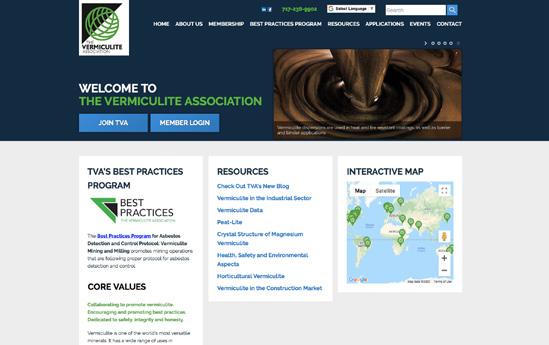
Overcoming Fear and Uncertainty
by Jeff TippettWhat holds you back?
Is it fear? You might be afraid to embrace new technology, because you’re set in the old ways. Or maybe it’s uncertainty; uncertainty that you can handle the challenges ahead, or that the direction you’re heading is the right one.
I understand that.
Arianna Huffington puts it well:
“We need to accept that we won’t always make the right decisions, that we’ll screw up royally sometimes — understanding that failure is not the opposite of success, it’s part of success.”
In my presentations, I emphasize to audiences that all change will be preceded by a mindset shift. Consider that all the results you are getting now are because of your current thinking. If you want to improve outcomes and get the results you deserve, you have to begin with a mindset shift.

First, before we tackle how to overcome fear, we should park for a second to define it. Fear is one of those words we toss around flippantly, but what does it really mean?
Fear is a reaction to a threat. Now, of course, if you see a bear in your yard one night and it starts sprinting toward you, we understand that sort of primal, fight or flight fear; “I need to run if I want to see tomorrow.” Another way to look at fear is in a more abstract way. Do you fear the unknown? It’s not that you know there is a bear in your yard, but what if you saw a story about it on the news one morning, and then had to go outside while it’s still dark? You may be afraid because you perceive a threat, even if one isn’t there.
Continued on next page...
So, sometimes, when we think about starting new things, or embracing new technology, fear can set in. We’re not afraid of laptops or smartphones, but rather we are (or were) uncomfortable with the unknown. It’s not a defect, it’s human nature.
Does this mean we just live with fear, and have no recourse in overcoming it? No!
There are plenty of solutions to overcome fear.
The first step is really just understanding it. What is it that leaves you uneasy? Uncertainty plays a big role in fear, just because we do not know the outcome of something we’ve yet to try. But taking time to consider the path you’ve chosen, the tools you’re using and how they differ from what you have now is important. In all things, it is better to analyze and consider the environment and how best to proceed. You don’t get any points for being the first one in, and in the last section we discussed how only a small number of the population are innovators. Taking time to survey the landscape will pay dividends before you invest everything in a risky idea.
Here’s another idea: Learn from others. While other people try new technology, pay attention to the results. Ask your peers and others in the same space as you what they’re using, and how they are seeing either success or difficulties with adapting to new technology.
One example of this is the cloud. At first, it may have seemed daunting to consider having all of your important files online and off your hard drive. Services like Dropbox and Google Drive make it easy for us to clean up the icons from our desktop, but it can still cause concern when you don’t see important documents right in front of you and safely stored in your folders.
But here is a chance for us to implement another tip: Practice. Just the other day, I gave a presentation and workshop to an association of nurses. Right as I was set to begin my slideshow, the file didn’t work. I panicked, for a moment, but then remembered that I had prepared for this exact problem. When I present, I always have a copy of the presentation on Google Drive, my laptop and on a flash drive. Hope for the best, but plan for the worst.
There, too, is another way to embrace change. Just because you are adapting to new technology, it doesn’t mean you have to discard all of the old ways. In fact, it’s better to ease into new things while you still have firm footing in the processes that make you comfortable. You can learn new, exciting ways to lead through technological innovations without betting the farm on a new process that isn’t tried and true.
As a leader, you may encourage the adoption of new material, but you might not be the one using it every day. It is important to listen to those who work around you to ensure they are making progress with new tech, and that their concerns are heard and addressed. It isn’t enough to buy new software and tell your team to figure it out; leaders are available to their teams and willing to lend an ear to correct course if needed.
“Do the best you can until you know better. Then, when you know better, do better.”
Maya AngelouWe understand what fear is now, and that there are a few things to keep in mind when moving forward with new technology. But how exactly can we conquer fear? Psychology Today has a great list of four steps to build confidence and conquer your fears, written by
Ellen Hendriksen, Ph.D.:1. Let the Movie Play Out
In this tip, Hendriksen suggests that we consider the implications of an action. What happens if you do x or y? Our mind tends to fixate on the worst possible outcome, and that’s natural. But if you continue “watching the movie,” what is the end? If you can look past the immediate obstacles, and play it out in your mind, you will often find that the results really aren’t as bad as you thought. It’s all about getting over the hump of doubt.
2. Find the Will
This is all about mindset. If you see yourself overcoming a challenge or fear, and know you can do it, half the battle is already won.
3. Write it Down, Then Prove it Wrong
Write what you’re afraid of, rebut the fear, consider all the options. You’ll see you’re stronger than the fear holding you back.
4. Break Your Fear Into Snack-Sized Pieces
As I said in #2, it’s about mindset. A lot of issues arise just because a topic seems too big to tackle, but breaking it down into smaller sizes makes even the largest burden manageable. With these in mind, take a quick analysis of yourself and the problem you face:
1. What’s the best that could happen?
2. What’s the worst that could happen?
3. Could you live with the worst that could happen with the possibility of the best that could happen?
If the answer to number three is yes, then it’s time to move. Your mind is holding you back.
So, now that we have the tools needed to move things forward, fear and uncertainty won’t hold you back.
About the Author: Jeff Tippett
Jeff Tippett is the international best-selling author of two books, Pixels Are the New Ink and Unleashing Your Superpower: Why Persuasive Communication is the Only Force You Will Ever Need. Speaking to international audiences through keynotes

and seminars, Jeff helps attendees increase their effectiveness, gives them powerful tools to reach their goals, and empowers attendees to positively impact and grow their organizations or businesses.
In 2014, Jeff founded Targeted Persuasion, an award-winning public affairs + communications firm. He has worked with renowned brands like Airbnb, The National Restaurant Association, The League of Women Voters, The League of Conservation Voters, plus others. Other industry experts have validated Jeff’s work with numerous awards including the prestigious The American Advertising Award.
Jeff is the host of Victory by Association with Jeff Tippett, a podcast that shares the victories of association executives with the world, highlighting the great work done across this country every day.
Jefftippett.com
Are You Blogging?
As you know, TVA launched a blog on its website to promote vermiculite and raise awareness of its uses.
We need your help to build this new resource. Have you written an article recently or have resources you can share that can be published on the blog?
We are looking for people to share: Construction Horticulture Industrial Best Practices
Health, Safety and Environmental Topics
If you have content that relates to these topics, please send articles and pictures to Michelle at communications@vermiculite.org
Check Out the Blog

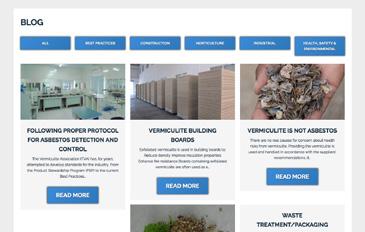
Articles for Lightweight News
TVA is always looking for articles for this newsletter to keep its contents relevant for our members. Articles should range from 200 to 500 words, and photos are welcome. Articles can be about a unique project you’ve been involved with, your company’s community involvement, an industry hot topic, an honor or award—really, anything you think your fellow TVA members would want to read about.
Email articles to TVALightweightNews@gmail.com
Our Mission:
To be the leading vermiculite association in the world and to gather, develop and disseminate accurate and truthful information and regulations, form and encourage collaborations, provide services and promote best practices to members, fund development of new uses and technologies and promote the knowledge and safe use of vermiculite on a global scale.
Lightweight News is an e-publication of The Vermiculite Association.
Material in this e-newsletter may be republished with permission of TVA and with proper line credit. Mention of commercial products in this publication is solely for information purposes, and endorsement is not intended by TVA. Material does not directly reflect the opinions or beliefs of the board or staff.
Additional Resources on the TVA Website
TVA’s website, www.vermiculite.org, contains a variety of resources, including these documents about vermiculite:
Vermiculite in the Construction Market
Horticultural Vermiculite
Health, Safety and Environmental Aspects
Crystal Structure of Magnesium Vermiculite
Peat-Lite
Vermiculite Concrete
Vermiculite Data
Vermiculite in the Industrial Sector
The Use of Vermiculite as a Technological Additive in Animal Feedstuffs
Vermiculite Gypsum Plasters
Contact Us:
THE VERMICULITE ASSOCIATION
2207 Forest Hills Drive
Harrisburg, PA 17112
Phone: 717-238-9902
Fax: 717-238-9985
Website: www.vermiculite.org
Staff Contacts:
Executive Director: Lisa Ruggiers tva@vermiculite.org
Director of Communications:
Michelle Keyser communications@vermiculite.org
TVA's staff wants you to get the most out of your experience with TVA. We are available to serve you, so please do not hesitate to contact staff with any question or concern that you may have. For a full staff listing, please click here
